NATIONAL MUSEUM OF AMERICAN HISTORY
Five of the Most Intriguing Electric Guitars at the National Museum of American History
Celebrate Jazz Appreciation Month this April with a look at five of the most exciting electric guitars at the National Museum of American History.
April is an important month for the guitar and music world: It's Jazz Appreciation Month! And no one exemplifies guitars quite like Les Paul. An American jazz, blues, and country guitarist and songwriter, Les Paul is remembered for his experiments with innovative recording techniques and with solid-body amplified guitars.

In a salute to one of the grandfathers of the unforgettable sound of the electric guitar, we are taking a moment today to look through the array of electric guitars in the National Museum of American History's collection. Did you know that the museum has over 90 acoustic and electric guitars and bass guitars in our musical instruments collection? Join us as we share five of our favorite electric guitars from the collection, highlighting exciting moments in history that led to the electric guitar as we know it today.
1. The Slingerland Songster Guitar
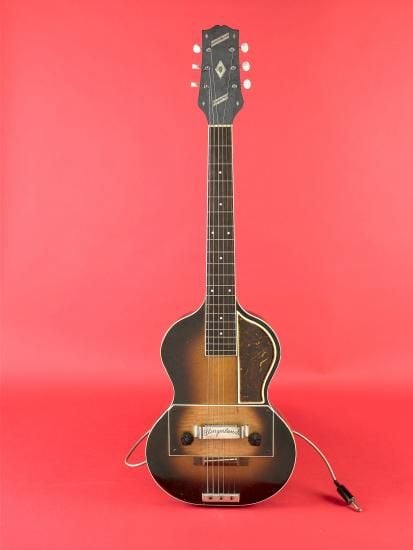
The concept of an electric guitar, or a guitar amplified "by means of electricity," started in the era of big band jazz, early recordings, and radio broadcasting, around the 1920s and into the 1930s, all around the singular challenge of making the guitar louder.
There were many early inventions and experiments that explored this challenge but, as we know today, what truly won out was the solid body electric guitar. Les Paul is widely known for his first attempts at a solid body guitar, nicknamed "the Log," developed in the early 1940s.
The Slingerland Company based in Chicago introduced a solid-body electric guitar for commercial sale in 1939 in their company catalog. Seen above, the guitar echoes the traditional "Spanish-style" acoustic guitar shape adapted to a solid wooden body with a combination of magnets in its pickup to capture string vibrations. While Slingerland stopped producing electric instruments in the 1940s to focus on percussion instruments, this guitar is possibly the earliest solid-body electric guitar on record.
2. Fender Electric Bass Guitar
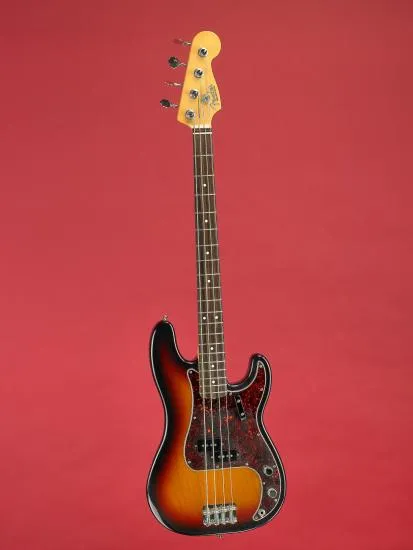
By the 1950s, the solid-body electric guitar had risen significantly in popularity, largely thanks to the jazz, blues, and country musicians who explored new sounds and ways to play with this electrified instrument. But what about the other stringed instruments in a band? In 1951, Leo Fender—whose company created the iconic Fender Telecaster and Stratocaster solid-body electric guitars—introduced the first electric bass that could be worn and played like a Spanish-style guitar.
The Precision Bass (or "P Bass" as it is usually known today) revolutionized the music world as it took the stand-up bass, an instrument that was difficult to transport, tune, and amplify, and simplified it down to the essentials. While there were already electrified versions of the upright bass, the ability to play the bass like a guitar was groundbreaking and its amplified voice became a musical sensation.
3. Silvertone Electric-Acoustic Guitar
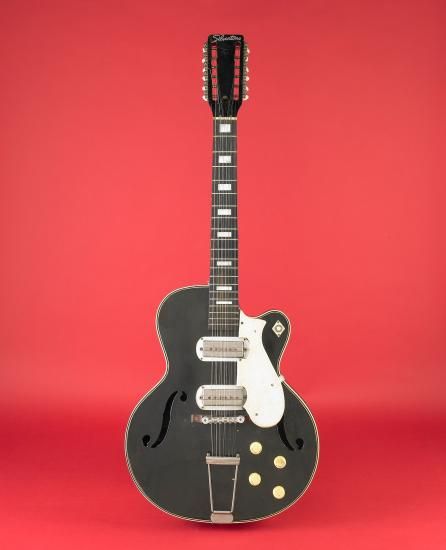
With the arrival of the 1960s, the cultural revolution of rock and roll was in full swing. Guitarists were less and less interested in the clean sounds that earlier musicians had sought to achieve and instead began experimenting with ways to create a more unique electric guitar voice that suited their own particular music and sound.
This Danelectro Silvertone acoustic-electric guitar belonged to Jesse Fuller (1896-1976) who purchased it from a Sears store in Detroit when his original guitar was stolen and he needed an instrument for a gig later that evening. A blues and folk music one-man-band, Fuller would play his guitar along with a harmonica, percussion and a foot-operated double-bass, which he built himself and dubbed "fotdella." Talk about unique sounds and innovations!
4. Eddie Van Halen's "Frankenstein"
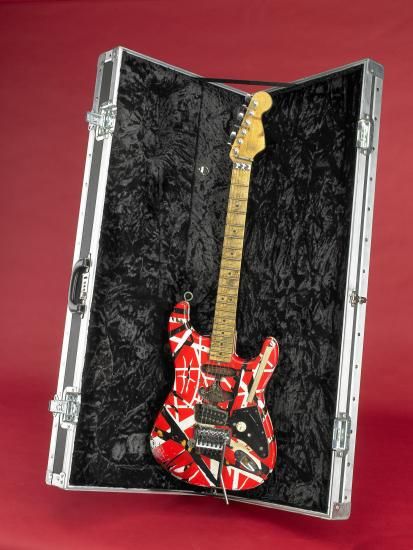
The search for even more volume with the rise of heavy metal music and the power chords, flashy solos, and raunchy sounds that defined rock and roll in the 1970s and 1980s led to changes in both the technology of the electric guitar and the aesthetic design.
In the 1970s, Eddie Van Halen began to experiment and push the limitations of his instruments, and ended up building his own electric guitar using the body of a Stratocaster and pieces and parts from other guitars. The end result was an instrument lovingly nicknamed by his fans as "Frankenstein," which he decorated with strips of colored tape.
5. Prince's Yellow Guitar
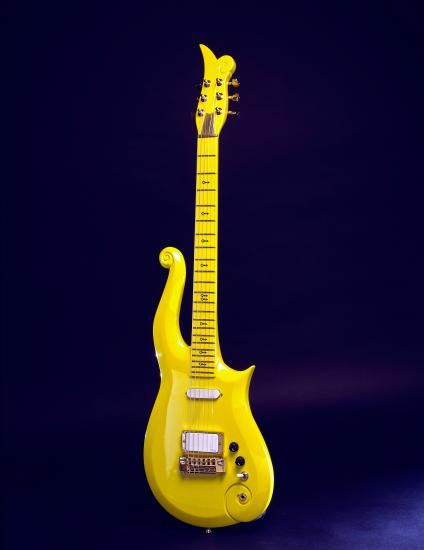
As guitarists sought to establish increasingly personalized musical styles, the visual design of guitars began to blossom. Because solid-body electric guitars don't depend on the physical shape to produce sound (as compared to hollow-body acoustic guitars), musicians and manufacturers alike could experiment more with the design and shape of the instrument itself. For music genres from heavy metal, to psychedelic rock—the guitars themselves became identifiable "signatures" of those styles.
Musicians were equally focused not only on the sounds they could tease out and create with this instrument, but also with the look. One of the best examples of this is none other than Prince's Yellow Cloud—which he designed himself and adorned with his distinctive symbol along the fingerboard.
So, are you ready to become a guitar expert and to learn more about the electric guitar's invention, commercial success, and design? Now that we've sampled a little bit of each decade, take a moment and journey through The Invention of the Electric Guitar online exhibit by the museum's own Lemelson Center for the Study of Invention and Innovation. It's a fascinating story about the creative people, groundbreaking technology, and inventive American spirit that coalesced to create this iconic instrument.
Want to learn more about the American experience through the transformative power of jazz? Check out the Smithsonian Jazz Team's website to explore the museum's jazz oral history collection, get tickets to performances by the Smithsonian Jazz Masterworks Orchestra, celebrate Jazz Appreciation Month, and more. Sign up to receive a monthly jazz e-newsletter from the museum for regular reminders.
